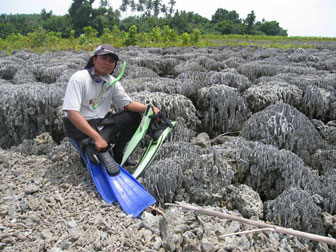Tsunami-producing quake caused mass coral death in Indonesia
Tsunami-producing quake caused mass coral death in Indonesia
WCS
April 11, 2007
Researchers say 300 kilometers of sea floor heaved more than a meter upwards, exposing — and killing — corals in unprecedented numbers
Scientists have reported what is thought to be one of the world’s greatest mass death of corals ever recorded as a result of the earthquake in Aceh, Indonesia on 28 March 2005.
The recent survey by scientists from the Wildlife Conservation Society – Indonesia Program and the Australian Research Council Centre of Excellence for Coral Reef Studies (ARCCoERS) investigated the condition of coral reefs in Pulau Simeulue and Pulau Banyak off Aceh, Indonesia, in March 2007.
The surveys covered 35 sites along 600 kms (372 miles) of coastline, have documented, for the first time, the effects of earthquake uplift on coral reefs. The entire island of Simeulue, with a perimeter of approximately 300 km (186 miles), was raised up to 1.2 m (3.9 feet) following the 28 March 2005 earthquake, exposing most of the coral reefs which ringed the island.

WCS researcher in front of an uprooted coral reef on Pulau Simeulue, Indonesia. (Credit: Wildlife Conservation Society)
Coral reefs decimated by 2050, Great Barrier Reef’s coral 95% dead. |
Dr Stuart Campbell coordinator of the Wildlife Conservation Society —Indonesia Marine Program reports: “This is a story of mass mortality on a scale rarely observed. In contrast to other threats like coral bleaching, none of the corals uplifted by the earthquake have survived”.
Dr Andrew Baird of ARCCoERS says: “Amazingly, the uplifted corals are so well preserved we could still identify each species, despite these colonies having been exposed for two years. Some species suffered up to 100 percent loss at some sites, and different species now dominate the shallow reef.”
“This is a unique opportunity to document a process that occurs maybe once a century and promises to provide new insights into coral recovery processes that until now we could only explore on fossil reefs” says Dr Baird.
Dr Campbell adds “The news from Simeulue is not all bad. At many sites, the worst affected species are beginning to re-colonize the shallow reef areas. The reefs appear to be returning to what they looked like before the earthquake, although the process may take many years.
“The challenge now is to work with local communities and government agencies to protect these reefs to ensure the recovery process continues,” he says.
The team found coral reefs ranging from highly diverse assemblages of branching corals in sheltered waters to vast areas of table corals inhabiting surf zones. The team also documented, for the first time in Indonesia, extensive damage to reefs caused by the crown-of-thorn starfish, a coral predator that has devastated reefs in Australia and other parts of the world.
“Finding the starfish damage is particularly important” says Dr Baird. “Most observers would attribute damage on this scale to more common reef threats in Indonesia such as cyanide fishing or bleaching. People monitoring Indonesian corals reefs now have another threat to watch out for, and not all reef damage should be immediately attributed to human influences.”
Many other reefs, particularly in the Pulau Banyak, continue to be damaged by destructive fishing including bombing and the use of cyanide. These practices are now illegal in Indonesia, and need immediate attention.
Dr Campbell concludes “While reef condition in south-western Aceh is generally poor, we have found some reefs in excellent condition as well as and evidence of recovery at damaged sites. This gives some hope that coral reefs in this remote region can return to their previous condition and provide local communities with the resources they need to prosper. The recovery process will be enhanced by management that encourages sustainable uses of these ecosystems and the protection of critical habitats and species to help this process.”
This is a modified news release from WCS.







